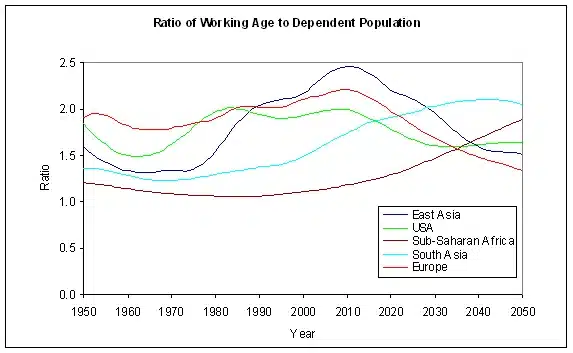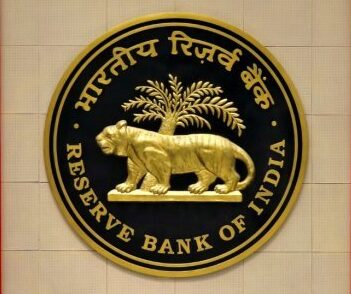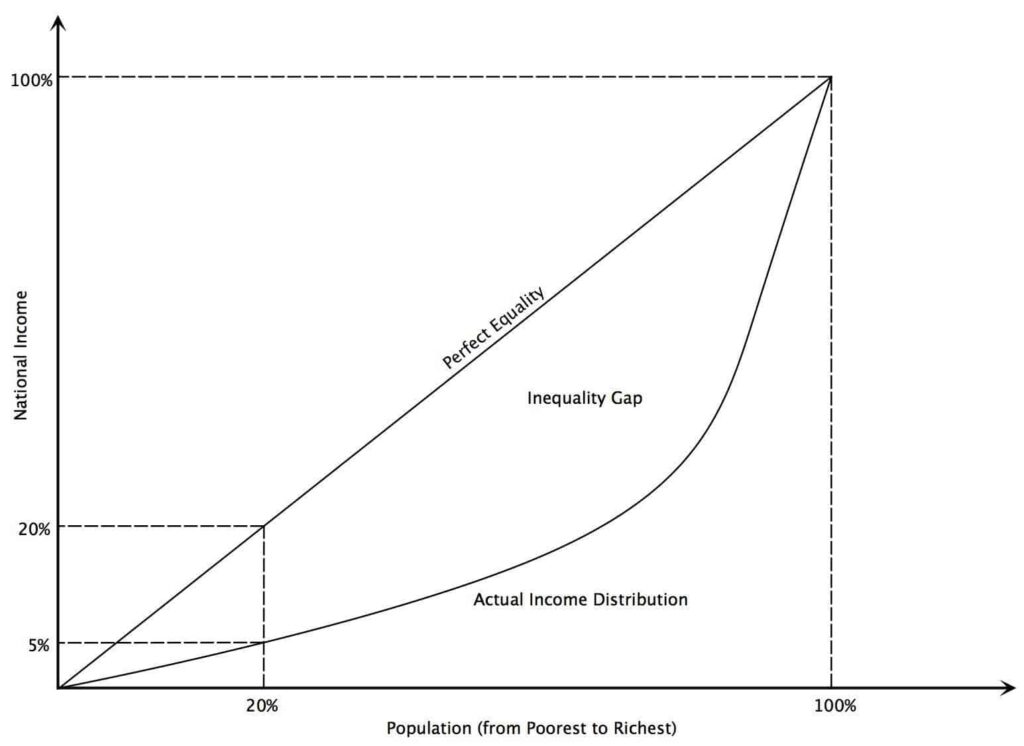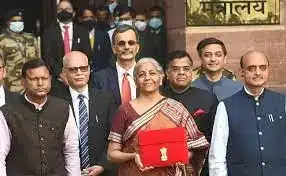Different Measures Of National Income
Gross Domestic Product (GDP)
- GDP is the total value of all final goods and services produced within the boundary of the country during a given time period, generally one year.
- All production done by the national residents or the non-residents in a country gets included, regardless of whether that production is owned by a local company or a foreign entity.
- The different uses of the concept of GDP are as given below:
- Per annum percentage change in it is the ‘growth rate’ of an economy.
- It is a ‘quantitative’ concept and its volume/size indicates the ‘internal’ strength of the economy. But it does not say anything about the ‘qualitative’ aspects of the goods and services produced.
- This is the most commonly used data in comparative economics. The GDPs of the member nations are ranked by the IMF at purchasing power parity (PPP).
Net Domestic Product (NDP)
- This measure allows policy-makers to estimate how much the country has to spend just to maintain their current GDP. If the country is not able to replace the capital stock lost through depreciation, then GDP will fall.
- Net Domestic Product (NDP) is the GDP calculated after adjusting the weight of the value of ‘depreciation’. This is, basically, net form of the GDP, i.e., GDP minus the total value of the ‘wear and tear’ (depreciation) that happened in the assets while the goods and services were being produced.
- Every asset (except human beings) go for depreciation in the process of their uses, which means they ‘wear and tear’. The governments of the economies decide and announce the rates by which assets depreciate (done in India by the Ministry of Commerce and Industry) and a list is published, which is used by different sections of the economy to determine the real levels of depreciations in different assets.
- NDP = GDP – Depreciation.
- NDP is not used in comparative economics, i.e., to compare the economies of the world. Why this is so? This is due to different rates of depreciation which is set by the different economies of the world.
- The different uses of the concept of NDP are as given below:
- (a) For domestic use only : to understand the historical situation of the loss due to depreciation to the economy. Also used to understand and analyse the sectoral situation of depreciation in industry and trade in comparative periods.
- (b) To show the achievements of the economy in the area of research and development, which have tried cutting the levels of depreciation in a historical time period.
- NDP MP =GDP MP –DEP
- NDPFC =NDPMP -Net ProductTaxes-Net ProductionTaxes
Gross National Product (GNP)
- Gross National Product (GNP) is the GDP of a country added with its ‘income from abroad’. Here, the trans-boundary economic activities of an economy is also taken into account. The items which are counted in the segment ‘Income from Abroad’ are:
- Private Remittances: This is the net outcome of the money which inflows and outflows on account of the ‘private transfers’ by Indian nationals working outside of India (to India) and the foreign nationals working in India (to their home countries).
- Interest on External Loans: The net outcome on the front of the interest payments, i.e., balance of inflow (on the money lend out by the economy) and outflow (on the money borrowed by the economy) of external interests. In India’s case it has always been negative as the economy has been a ‘net borrower’ from the world economies.
- External Grants: The net outcome of the external grants i.e., the balance of such grants which flow to and from India. Today, India offers more such grants than it receives.
- The normal formula is GNP = GDP + Income from Abroad. But it becomes GNP = GDP + (– Income from Abroad), i.e., GDP – Income from Abroad, in the case of India. This means that India’s GNP is always lower than its GDP.
- GNPMP= GDP MP + NFIA
- GNP FC =GNP MP -Net ProductTaxes-Net ProductionTaxes
- The different uses of the concept GNP are as given below:
- (i) It is a more exhaustive concept of national income than the GDP as it indicates towards the ‘quantitative’ as well as the ‘qualitative’ aspects of the economy, i.e., the ‘internal’ as well as the ‘external’ strength of the economy.
- (ii) It enables us to learn several facts about the production behaviour and pattern of an economy, such as, how much the outside world is dependent on its product and how much it depends on the world for the same (numerically shown by the size and net flow of its ‘balance of trade’); what is the standard of its human resource in international parlance (shown by the size and the net flow of its ‘private remittances’); what position it holds regarding financial support from and to the world economies (shown by the net flow of ‘interests’ on external lending/borrowing).
Net National Product (NNP)
- This is a measure of how much a country can consume in a given period of time. NNP measures output regardless of where that production has taken place (in domestic territory or abroad).
- Net National Product (NNP) of an economy is the GNP after deducting the loss due to ‘depreciation’.
- The formula to derive it may be written like:
- NNP = GNP – Depreciation
- NNP = GDP + Income from Abroad – Depreciation.
- NNPMP =GNPMP –Depreciation
- NNPMP= NDPMP+ NFIA
- NNPFC or NI =NNPMP – Net ProductTaxes-Net ProductionTaxes
- The different uses of the concept of NNP are as given below:
- This is the ‘National Income’ (NI) of an economy. Though, the GDP, NDP and GNP, all are ‘national income’ they are not written with capitalised ‘N’ and ‘I’.
- This is the purest form of the income of a nation.
- When we divide NNP by the total population of a nation we get the ‘per capita income’ (PCI) of that nation, i.e., ‘income per head per year’.
National Income calculated by three ways:
Value Added Method (or the Production Method)
- The value added or production method is used by economists to calculate GDP at market prices, which is the total values of outputs produced at different stages of production. It needs to be mentioned that caution should be taken to take final Goods and not Intermediate goods, as it will result in Double Counting.
- Some of the goods and services included in production are:
- Goods and services actually sold in the market.
- Goods and services not sold but supplied free of cost.
- Some of the goods and services not included in production are:
- Second hand items and purchase and sale of the same. Sale and purchase of second cars, for example, are not a part of GDP calculation as no new production takes place in the economy.
- Production due to unwarranted/ illegal activities.
- Non-economic goods or natural goods such as air and water.
- Transfer Payments such as scholarships, pensions etc. are excluded as there is income received, but no good or service is produced in return.
- Imputed rental for owner-occupied housing is also excluded
- GDP at current market price : Σ(GVA of all goods and services produced) +tax – subsidies
Income Method
- This method emphasises on aggregating the payments made by firms to households, called factor payments.
- It is defined as total income earned by citizens and businesses of a country. There are four types of factors of production and four types of factor incomes accordingly i.e. Land, Labour, Capital and Entrepreneur/Organization as Factors of Production and Rent, Wages, Interest and Profit as Factor Incomes correspondingly.
- GDP = Wages+ Interest Income + Rental Income +Profit +Indirect Taxes-Subsidies+ Depreciation
- The term Profit can be further sub-divided into: profit tax; dividend to all those shareholders; and retained profit (or retained earnings).
- Such an approach is adopted in India to calculate the contribution of services sector to the economy.
- Any income corresponding to which there is no flow of goods and services or value added, it should not be included in calculation by Income method.
Expenditure Method
- The expenditure method measures the final expenditure on GDP. Amount of Expenditure refers to all spending on currently-produced final goods and services only in an economy. In an economy, there are three main agencies, which buy goods and services. These are: Households, Firms and the Government
- This final expenditure is made up of the sum of four expenditure items, namely:
- Consumption (C): Personal Consumption made by households, the payment of which is paid by households directly to the firms which produced the goods and services desired by the households.
- Investment Expenditure (I): Investment is an addition to capital stock of an economy in a given time period. This includes investments by firms as well as governments sectors
- Government Expenditure (G): This category includes the value of goods and service purchased by Government. Government expenditure on pension schemes, scholarships, unemployment allowances etc. are not included in this as all of them come under transfer payments.
- Net Exports (X-IM): Expenditure on foreign made products (Imports) are expenditure that escapes the system, and must be subtracted from total expenditures. In turn, goods produced by domestic firms which are demanded by foreign economies involve expenditure by other economies on our production (Exports), and are included in total expenditure. The combination of the two gives Net Exports.
- GDP= C+I+G+X-IM ; C= consumption, I= investment, G= government expenditure, X= export, IM= import.
New Methodology for Calculation of GDP in India
- The Central Statistics Office (CSO), in January 2015, released the new and revised data of National Accounts.
- Headline growth rate will now be measured by GDP at constant market prices, which will henceforth be referred to as ‘GDP’ (as is the practice internationally). Earlier, growth was measured in terms of growth rate in GDP at factor cost and at constant prices.
- The Base Year was revised from 2004–05 to 2011–12. This was done in accordance with the recommendation of the National Statistical Commission (NSC), which had advised to revise the base year of all economic indices every five years.
- This time, the methodology of calculating the National Accounts has also been revised in line with the requirements of the System of National Accounts (SNA)-2008, an internationally accepted standard.
- GDP = GVA at basic prices + product taxes – product subsidies.
- GVA at basic prices =compensation of employees +operating surplus/mixed income + consumption of fixed capital (i.e., deprication) + production taxes less production subsidies.
- GVA at factor cost = GVA at basic prices – production taxes + production subsidies.
- Production taxes or production subsidies are paid or received with relation to production and are independent of the volume of actual production.
- Some examples of production taxes are land revenues, stamps and registration fees and tax on profession.
- Some production subsidies are subsidies to Railways, input subsidies to farmers, subsidies to village and small industries, administrative subsidies to corporations or cooperatives, etc.
- Product taxes or subsidies are paid or received on per unit of the product.
- Some examples of product taxes are excise tax, sales tax, service tax and import and export duties.
- Product subsidies include food, petroleum and fertilizer subsidies, interest subsidies given to farmers, households, etc., through banks, and subsidies for providing insurance to households at lower rates].
Green GDP
- Green GDP is a term used generally for expressing GDP after adjusting for environmental damage. When information on economy’s use of the natural environment is integrated into the system of national accounts, it becomes green national accounts or environmental accounting.
- The process of environmental accounting involves three steps viz. Physical accounting; monetary valuation; and integration with national Income/wealth Accounts. Physical accounting determines the state of the resources, types, and extent (qualitative and quantitative) in spatial and temporal terms. Monetary valuation is done to determine its tangible and intangible components. Thereafter, the net change in natural resources in monetary terms is integrated into the Gross Domestic Product in order to reach the value of Green GDP.
Also refer :









